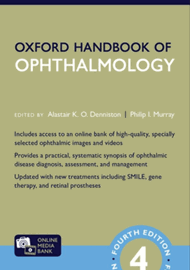No matter what speciality you do there will always be a couple of core textbooks that everyone seems to recommend. When it comes to ophthalmology one of the most commonly cited ones is the Oxford Handbook of Ophthalmology. Having used it for a little while now – I can see why. It’s an incredibly practical book no matter what stage in your training you are.
It starts off with the basics; clinical skills and investigations. In the first chapter it walks you through essential skills such as how to take an ophthalmic history, use a slit-lamp, measure intraocular pressures and how to examine the anterior and posterior segment. It also tackles slightly trickier skills like gonioscopy. The investigation chapter goes into a little bit more depth about ophthalmic specific imaging. It even includes a section about the ever trendy optical coherence tomography angiography (OCTA).
The subsequent chapters take you systematically through the various sub-specialities. Throughout each chapter it succinctly explains what you need to look for and often has extremely useful summary tables.
From chapter 20 onwards are chapters which could be easy to miss, but I recommend having a good look through. First of all there’s the ‘Aids to diagnosis’. Here you’ll find a concise summary of causes of common complaints such as headache and sudden loss of vision. There’s also a rundown of common causes of signs in the anterior and posterior segment, causes of different visual field defects, and even nystagmus.
The chapter on ‘vision in context’ is a nice mix of how to look after your patient holistically, as well as criteria regarding driving standards and free sight test vouchers.
There’s an excellent couple of chapters going through lasers and therapeutics that are commonly used. It doesn’t just tell you about the medicines but gives you typical treatment regimes, and practical advice such as how to carry out certain types of laser or procedures such as a subtenons block or intravitreal injection.
For those of us who are new to theatre there’s even a section on surgical instruments, what they’re used for and a little diagram of what they look like.
As you come to the end there’s a very handy section on evidence-based medicine which is a crash course in the various types of study, terms and patient reported outcomes.
You finally finish on chapter 27 – resources. Here you can find a couple of sentences about various eponymous syndromes, and also some recommended web based resources for both yourself and patients.
For those who have tried it before and been put off by its lack of pictures, I recommend trying it again. The fourth edition has addressed this particular complaint by giving you access to an extensive online media bank.
For a handbook it is quite sizeable and at times I’ve struggled to ram it into my laptop bag or handbag, but it’s worth it. It truly is invaluable for any healthcare professional working in ophthalmology.




